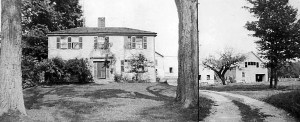NORWAY — A donation of old photographs showing the Roberts Farm on Pikes Hill has opened up a new view of the historic farm complex beyond the remaining farmhouse and old building foundations.
“I literally had one photo that showed a barn and photos of cows,” said Lee Dassler of the Western Foothills Land Trust. She met recently with descendants of the John Roberts family — the Rev. Richard Ray of Minot and his family — to accept a gift of photographs taken during the 20th century.
“Meeting the Rays and having the family share photos has been wonderful for us,” Dassler said. The photographs were taken in the mid-20th century by John A. Roberts II, an engineer at General Electric in Lynn, Mass., who died in 2005.
“Maybe because he worked as a designer and inventor (he shared credit for many patents), he approached his childhood home in Norway with an artistic eye and a sensibility towards a fleeting way of life,” Dassler said.
The 150-acre property was purchased by the Western Foothills Land Trust in 2009. Since then, the farmland on Pikes Hill has been developed into a trail system for hikers, cross-country skiers and others. The original 1823 hip-roof farmhouse is being restored for meeting space and farmstead exhibits on the first floor and Land Trust offices above.
The trust is using plans developed this past school year by Oxford Hills Technical School students in John Bell’s Engineering and Architectural Design class, Dassler said. Student Chris Fitch’s work will form an essential foundation for the rehabilitation, she said.
Although the farmhouse still exists, only foundations largely remain of other buildings on the property. With the newly acquired photographs, the trust will now be able to see the farm complex as it once was.
“These photos are important to the trust and to the greater community on so many levels,” Dassler said. “In terms of the farmhouse rehabilitation and future farmstead design, the newly shared Roberts family photos convey a density of agricultural and residential structures we could not have guessed at based upon surviving foundations.”
Dassler said the photographs provide guidance in terms of mass, proportion, fenestration and materials that can now be accessed as the project goes forward.
“They are also significant in terms of providing a record of the pre-World War II rural landscape in Norway,” Dassler said. “The woods we cut trails through in 2009 were working fields and pastures in the ’40s. Stone walls that bisect the forested trail system now were exposed and in use managing the dairy herd.”
Dassler said they can now also see in the photographs what they knew from researching probate and other records: that the fields, pastures, orchards and agricultural buildings on the farm were in decline by the mid-1900s.
“There is a humanity and parallel story of small farm animal husbandry that are conveyed through photos of the family, the Jersey herd, chickens and farm equipment,” she said.
“Meeting the Rays and having the family share photos has been wonderful for us,” she said.
History of the Roberts Farm farmland
The 150 acres that is now the Roberts Farm Preserve was historically part of the extensive holdings of Dudley Pike, one of Norway’s founders. By 1787, Pike, for whom the steep hill south of Norway was named, had acquired this land from Henry Rust, according to information provided from the Western Foothills Land Trust.
Between 1820-1830, Dudley’s son Henry built a two-story home and began farming the property. By 1850, the farm included 52 acres of improved land and was producing “Indian” corn, oats, peas, potatoes, hay, milk, butter and cheese. By 1880, 72 acres were under cultivation.
In 1881 Henry gave the farm to his daughter Carrie and her husband, John Roberts. Roberts farmed “scientifically” and was very active in the Maine State Grange. He also served as the state’s Commissioner of Agriculture from 1913 until his death in 1918. Carrie and John’s son Thaddeus continued to farm the land and developed a dairy herd that brought the family modest success.
In 2000, after two centuries of stewardship by the Pike-Roberts family, the land was sold for timber harvest and potential development. The Western Foothills Land Trust agreed to purchase the property in the summer of 2007.




Comments are no longer available on this story